
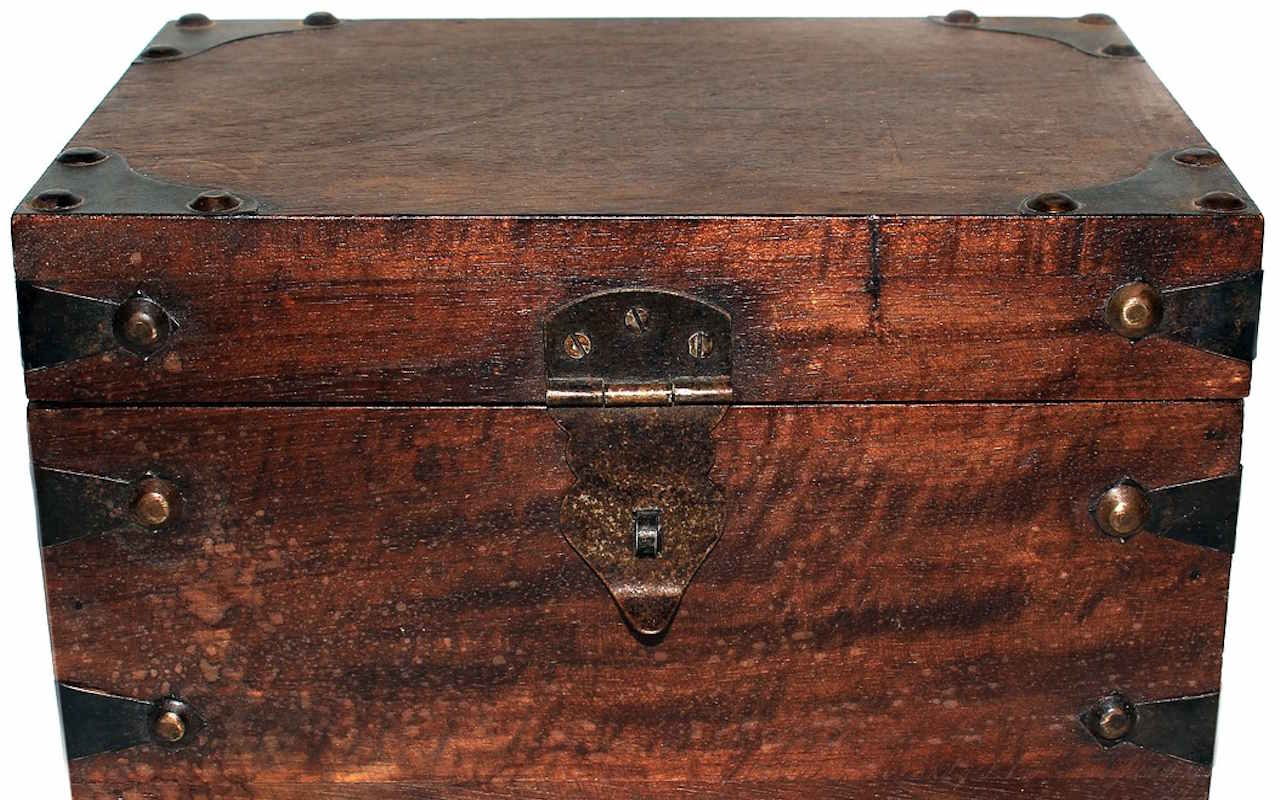
Whatnot has fundamentally transformed its approach to surprise product sales through a series of precise policy updates. The platform’s new guidelines aim to eliminate ambiguity and potential manipulation in online collectible sales.
Here is the full story of the controversy surrounding Whatnot Mystery Box policy changes.
Let’s cut through the noise. Whatnot’s surprise boxes aren’t just another random unboxing—they’re a carefully regulated collector’s experience with real rules and real stakes.
Here’s the official breakdown: Every surprise set on Whatnot comes with ironclad guidelines. The minimum value isn’t some throwaway number—we’re talking $150 for a standard bag and $50 for accessories.
These aren’t just suggestions; they’re platform mandates designed to protect collectors from getting burned.
The livestream is your guarantee. Every single item gets unveiled on camera, in real-time. No smoke, no mirrors. Sellers must keep everything visible, creating a transparent ecosystem where what you see is precisely what you get. This isn’t just a transaction—it’s a public performance of collecting.
Sellers aren’t just random folks with a box of cards. They must be approved by Whatnot, vetted and verified. Think of it like a collector’s guild, where entry requires more than just inventory—it demands reputation.
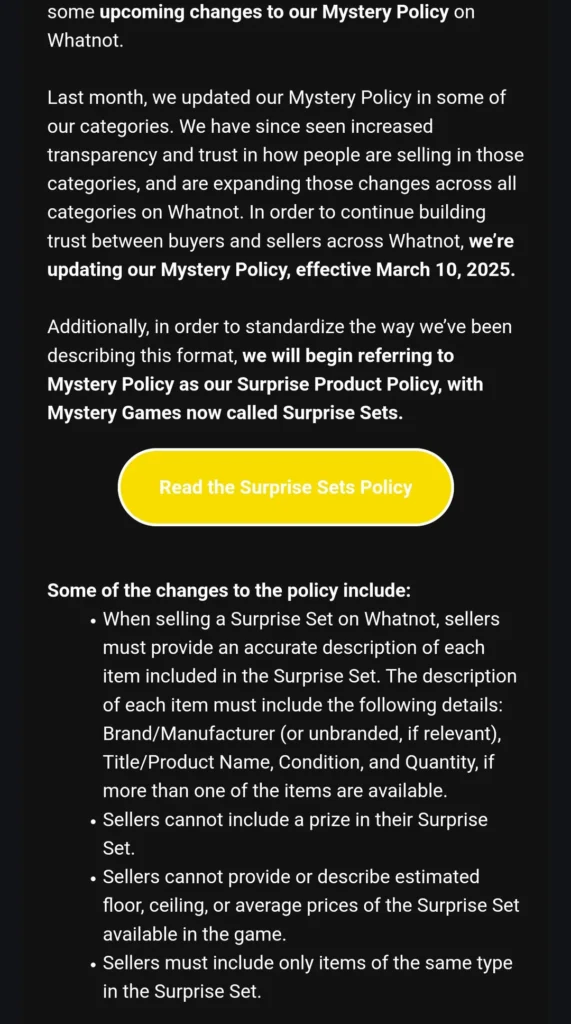
But here’s the kicker: This isn’t gambling. This is a calculated risk for serious collectors. Each box represents a curated potential, a sealed narrative waiting to unfold. Will you hit that vintage rookie? Snag a game-used patch? The anticipation is the real prize.
Not for the faint of heart. Definitely not for those who prefer safe, predictable purchases. But for true collectors? This is where legends are born—one carefully regulated surprise box at a time.
At its core, Whatnot’s new policy is a comprehensive attempt to bring transparency, fairness, and clear guidelines to surprise product sales.
The policy fundamentally redefines how sellers can market and sell mystery boxes across various categories, with strict rules designed to protect buyers and create a more trustworthy marketplace.
The policy goes into full effect on March 10, 2025, giving sellers time to adapt to these comprehensive new guidelines.
The Great Whatnot Surprise Box Revolt of 2025: A Collector’s Manifesto
In the wild world of online collecting, Whatnot just dropped a policy bomb splitting the community faster than a PSA 10 card splits opinion.
When Whatnot announced its new surprise box policy, the community erupted. Some sellers saw it as a necessary cleanup, others as a regulatory apocalypse. One seller bluntly stated, “They purposely make these hard to interpret?”
Gone are the days of vague “potential value” promises. The new policy demands:
While in theory, this provides more transparency, it can also give cover to scammers.
Some collectors are cheering. One seller admitted, “I’ve dabbled with mystery boxes in other categories… and have gotten fucked on value every single time.” Others are seeing red.
The frustration is palpable. Another seller bluntly called it a “Stupid rule update”, while others are more nuanced. One particularly frustrated voice declared, “The wording of this is terrible! I’m completely lost, to be quite honest, and I’m not an idiot.”
The new rules only allow buyers to some moments of video when their cards are drawn. That provides a lot of scope for cons.
Take a look at this video of Chicagohitz scamming someone by taking the cards off camera in order to “put on music” and making a $350 card disappear. What is hilarious is how long and cumbersome this scam is. It was six minutes of him playing around, turning on and off music.
Claiming that he may have dropped a card when someone pointed it out. The dude is such a transparent amateur. If you are going to scam, be set up to do it properly.
You can see their reaction to being caught here:
The new policy makes scams like this a lot easier by only allowing customers access to a few seconds of their cards being hit.
But because of the new policy, customers who were scammed cannot go back and watch the full long scam. Which is probably something that Chicagohitz knew very well and took advantage of.
Whatnot is cooperating, whether knowingly or unknowingly. That undermines the trust in the entire platform.
When Whatnot announced its latest policy changes for “Surprise Sets”, it didn’t just modify rules—it ignited a powder keg of seller and collector frustration.
The new guidelines aim to create transparency, but many argue they’ve created more confusion. The most contentious change? Sellers can no longer reference floor, ceiling, or average values for their mystery products.
The transparency paradox runs deep. By removing the ability to provide value ranges, Whatnot has essentially created a black box of uncertainty.
Previously, sellers could give potential buyers a framework of expected value. Now, they’re forced into a more opaque model that could potentially increase mistrust. One user on Reddit captured this frustration perfectly: “Only consequential change I see is the fact that Whatnot is removing the Floor, Average & Ceiling dollar amounts & this will spawn even more scammers and swindlers.”
The irony is palpable—a policy designed to prevent fraud might actually create more opportunities for it.
One seller captured the collective sentiment bluntly: “Whatnot is an effing cesspool, and they just made it easier for scammers to scam.” The frustration isn’t just about rules—it’s about perceived platform incompetence.
The visceral reaction speaks to a deeper issue of platform trust. Collectors and sellers have built entire businesses and communities on Whatnot, and this policy feels like a unilateral change that undermines their economic ecosystem.
The language of frustration—words like “cesspool” and “scammers”—reveal a community that feels fundamentally misunderstood by the platform they’ve supported.
Perhaps the most nuanced critique comes from a seller questioning the definition of a “prize” item. As one passionate collector noted:
“Is a rare item still allowed? If I have 95 items valued at $50 and 5 items valued at $80, are those now considered forbidden ‘rare prizes’? If that’s the case, what’s even the point of surprise products?”
This philosophical question cuts to the heart of collecting culture. Mystery boxes aren’t just transactions—they’re experiences, narratives, moments of potential.
The thrill of potentially pulling a rare item is what transforms a simple purchase into an event. By potentially eliminating this element, Whatnot risks turning vibrant, exciting exchanges into bland, predictable transactions.
The policy seems to create more questions than answers. Some specific concerns:
These aren’t merely theoretical concerns. One seller highlighted the complexity by discussing current market practices, particularly around companies like Otia that typically auction products with a floor of $0.01 and a ceiling of $10,000-$15,000.
Their current model, where a “$300 pack” might contain mostly $30-$80 cards with a tiny chance of a high-value item, could be completely disrupted.
The potential ripple effects are significant. Collectors aren’t just buying products—they’re participating in a complex ecosystem of risk, chance, and potential. By attempting to standardize this ecosystem, Whatnot might be destroying the excitement that makes these transactions compelling.
Perhaps most telling is the community’s cynicism about enforcement. One blunt commenter summed it up: “Can’t wait to watch no one follow this and Whatnot do nothing about it.”
This comment reveals a deeper institutional distrust. It’s not just that sellers disagree with the policy—they fundamentally don’t believe Whatnot has the capability or desire to enforce it.
This speaks to a history of inconsistent moderation and a perception that the platform is more interested in creating rules than genuinely protecting its community.
The policy introduces category-specific minimum value requirements:
However, many argue these cosmetic changes don’t address fundamental trust issues.
These requirements feel like a bureaucratic band-aid on a much deeper wound. By creating arbitrary price floors, Whatnot treats symptoms rather than root causes. A $35 minimum for sports memorabilia doesn’t prevent fraud—it just creates a new set of rules for potential manipulation.
What emerges isn’t just a policy debate—it’s a referendum on Whatnot’s relationship with its community. Sellers and collectors don’t just want rules; they want fair, clear, transparent guidelines that respect the ecosystem’s complexity.
One seller captured this sentiment perfectly: “If it wasn’t for the chance of something surprising, we’d all be better off selling on eBay.”
This quote is more than just criticism—it’s a warning. Platforms live and die by their communities. By potentially removing the core excitement of surprise products, Whatnot risks turning its vibrant, engaged user base into transactional, disinterested sellers and buyers.
The March 10, 2025 implementation date looms. But for many in the Whatnot community, it feels less like a solution and more like another problem.
In the high-stakes world of collectibles, transparency sounds good on paper. But in practice? Whatnot might just be shuffling the deck without understanding the game.
The March 10th policy implementation is more than a rulebook update—it’s a potential inflection point for the entire mystery box ecosystem. By attempting to sanitize the “surprise” out of surprise sets, Whatnot risks killing the magic that makes collecting exciting.
Collectors aren’t looking for perfect protection. They’re looking for controlled chaos. The thrill isn’t just in the purchase—it’s in the possibility. A $35 sports memorabilia floor doesn’t create trust. Genuine community engagement does.
Prediction: Expect significant seller exodus if these rules aren’t dramatically revised. The first month after implementation will be critical. Smart sellers will already be exploring alternative platforms, and Whatnot knows it.
I hit a SWEET auto from the #1 overall pick at PCB hobby
The Ultimate 2024 Football Card Brand Tier List (Panini vs. Topps and more!)
2025 Topps All Star Game Mega Box Product Review
Ripping the new Topps All Star Game mega box.
Is this new sports card store the BEST VALUE around?
I Tested eBay Auction Promotions So You Don’t Have To!
I deep-dove on Fanatics Collect so you don't have to (but should you?)
Panini is launching a WNBA Product at $30,000!?


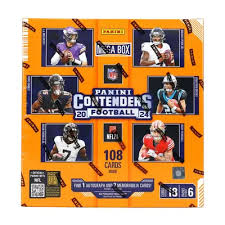
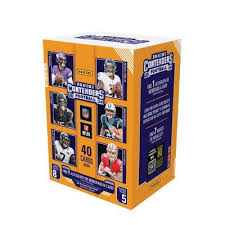
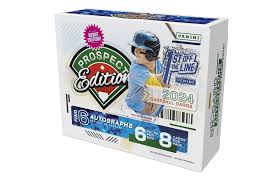
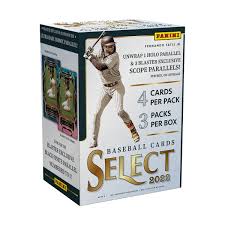
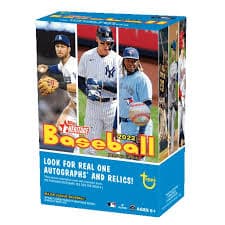
2022 Topps Heritage Baseball Blaster Box Configuration: 7 Packs per Box – 9 Cards per Box. Plus 1 extra pack.
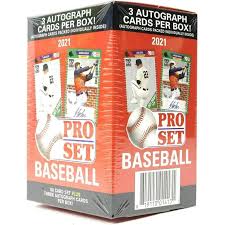
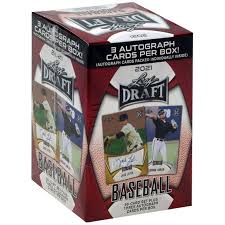
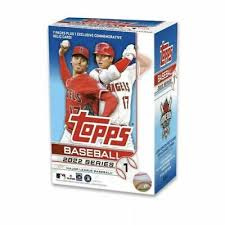






Keep up on breaking Sports Card News, our latest articles, product specials and exclusive content with expert analysis of hobby trends.

© Copyright 2025 - All rights reserved Cardlines.com / Media Techs LLC - Sports Card News, Reviews, Releases and BREAKS - #thehobby.
Important: When you click on links to various merchants on this site and make a purchase, this can result in this site earning a commission. Affiliate programs and affiliations include, but are not limited to, the eBay Partner Network.
Sports Card Scavenger Hunt! (5,000 Subscriber Special!)
Cardlines 70 minutes ago